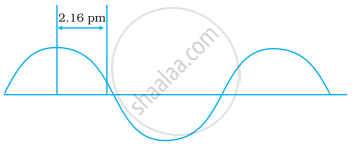Advertisements
Advertisements
Question
Following results are observed when sodium metal is irradiated with different wavelengths. Calculate (a) threshold wavelength and, (b) Planck’s constant.
| λ (nm) | 500 | 450 | 400 |
| v × 10-5 (cm s-1) | 2.55 | 4.35 | 5.35 |
Solution 1
Assuming the threshold wavelength to be `lambda_0 " nm"(= lambda_0 xx 10^(-9)" m")`, the kinetic energy of the radiation is given as:
`"h" ("v" - "v"_0) = 1/2 " mv"^2` ...........(i)
Since v = `"c" / λ`, the equation (i) can write the following types-
`"hc" [1/λ - 1/λ_0] = 1/2 "mv"^2` ..............(ii)
Upon replacing the results given by the three experiments in the equation (ii),
`"hc"/10^-9 [1/500 - 1/λ_0] = 1/2 "m" xx (2.55 xx 10^6)^2` .......(iii)
`"hc"/10^-9 [1/450 - 1/λ_0] = 1/2 "m" xx (4.35 xx 10^6)^2` .....…(iv)
`"hc"/10^-9 [1/400 - 1/λ_0] = 1/2 "m" xx (5.35 xx 10^6)^2` ........…(v)
Dividing equation (iv) by equation (iii)
`(λ_0 - 450)/(450 λ_0) xx (500 λ_0)/(λ_0 - 500) = [4.35/2.55]^2`
or `(λ_0 - 450)/(λ_0 - 500) = [4.35/2.55]^2 xx 450/500` = 2.619
or λ0 − 450 = 2.619 λ0 − (500 × 2.619)
or 1.619 λ0 = 1309.5 − 450 = 859.5
or λ0 = `859.5/1.619` = 530.88 = 531 nm
The value of the Planck’s constant is H, the value of the λ0 can be obtained on replacing in one of the three classes.
Solution 2
Let the threshold wavelength to be λ0 nm = λ0×10-9 m .
Following equation holds true for photoelectric emission in given case:
K.E. = 1/2 mv2 = h(ν - ν0)
⇒1/2 mv2 = hν - hν0
⇒ hν0 = hν - 1/2 mv2
⇒ hc/λ0 = hc/λ - 1/2 mv2
`=> lambda_0 = 1/(1/lambda - 1/2 m/hc v^2) = 1/(1/lambda - 1/2 (9.1xx10^(-31))/(6.6xx10^(-34)xx3xx10^8))v^2`
a) Substituting the value of λ and v from the above given data, we get three values of λ0 as,
λ0(1) = 541 nm
λ0(2) = 546 nm
λ0(3) = 542 nm
Threshold frequency = λav = {λ0(1)+λ0(2)+λ0(3)}/3 = (541+546+542)/3 = 543 (approx 540)
Notes
Note: part (b) of the question is not done due to the incorrect values of velocity given in the question
APPEARS IN
RELATED QUESTIONS
Yellow light emitted from a sodium lamp has a wavelength (λ) of 580 nm. Calculate the frequency (ν) and wave number (`bar v`) of the yellow light.
Find energy of each of the photons which have the wavelength of 0.50 Å.
What is the number of photons of light with a wavelength of 4000 pm that provide 1 J of energy?
A photon of wavelength 4 × 10–7 m strikes on the metal surface, the work function of the metal being 2.13 eV. Calculate
- the energy of the photon (eV),
- the kinetic energy of the emission, and
- the velocity of the photoelectron (1 eV = 1.6020 × 10–19 J).
A 25-watt bulb emits monochromatic yellow light of the wavelength of 0.57μm. Calculate the rate of emission of quanta per second.
Electrons are emitted with zero velocity from a metal surface when it is exposed to radiation of wavelength 6800 Å. Calculate threshold frequency (v0) and work function (W0) of the metal.
The electron energy in the hydrogen atom is given by En = (–2.18 × 10–18)/n2 J. Calculate the energy required to remove an electron completely from the n = 2 orbit. What is the longest wavelength of light in cm that can be used to cause this transition?
In astronomical observations, signals observed from the distant stars are generally weak. If the photon detector receives a total of 3.15 × 10–18 J from the radiations of 600 nm, calculate the number of photons received by the detector.
The work function for caesium atom is 1.9 eV. Calculate
- the threshold wavelength and
- the threshold frequency of the radiation. If the caesium element is irradiated with a wavelength 500 nm, calculate the kinetic energy and the velocity of the ejected photoelectron.
The ejection of the photoelectron from the silver metal in the photoelectric effect experiment can be stopped by applying the voltage of 0.35 V when the radiation 256.7 nm is used. Calculate the work function for silver metal.
If travelling at same speeds, which of the following matter waves have the shortest wavelength?
Which of the following will not show deflection from the path on passing through an electric field?
A hypothetical electromagnetic wave is shown in Figure. Find out the wavelength of the radiation.

What is photoelectric effect? State the result of photoelectric effect experiment that could not be explained on the basis of laws of classical physics. Explain this effect on the basis of quantum theory of electromagnetic radiations.
